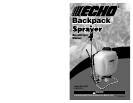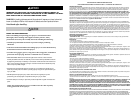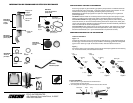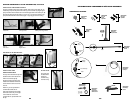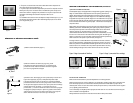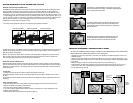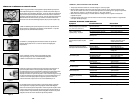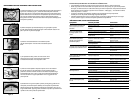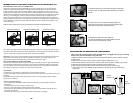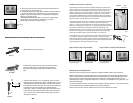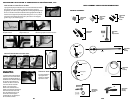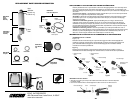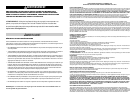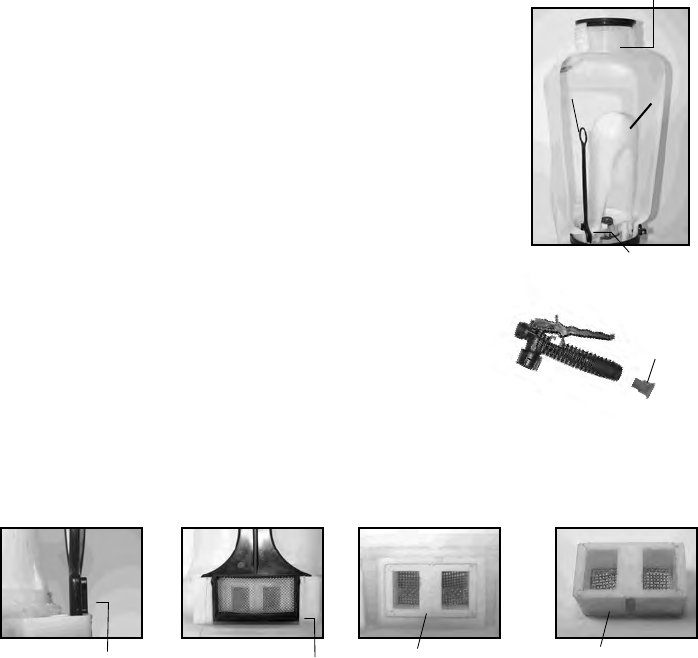
4E
Stage 4
(Removable
Shut-off filter)
4 STAGE FILTERING SYSTEM
This backpack sprayer is equipped with a 4 stage filtering system (see figure 1).
Stage 1 is a filter basket incorporated into the tank opening where fluid is
added. Stage 2 and 3 filters are located at the inlet of the pressure cylinder.
Stage 2 is a removable In-Tank filter. Stage 3 is a removable filter cartridge
integrated into the pressure cylinder. Stage 4 is a removable filter incorporated
into the shut-off assembly. Periodic cleaning of these filters is recommended to
insure consistent fluid flow through the sprayer. This will also reduce sprayer
component wear.
Stage 3 filter cartridge cleaning requires removal of the entire pressure cylinder
assembly (see section “disassembling and repairing the pressure cylinder”).
Once the pressure cylinder is removed the stage 3 filter can be removed for
cleaning (see figure 3). Periodic cleaning of the stage 2 filter is highly
recommended and will reduce the need to perform this disassembly. It is best
to have no or minimal fluid in the tank before removing and reinstalling the
stage 2 In-Tank filter. The In-Tank filter needs to be oriented in a specific way
when inserted into the pressure cylinder base (see figure 2).
The stage 4 filter is a removable filter incorporated into the inlet side of the
shut-off valve (see section “disassembling and repairing the shut-off valve”) .
Make sure pressure is released before detaching the hose from the shut-off. It
is best to have no or minimal fluid in the pressure cylinder before removing
and reinstalling the stage 4 shut-off filter as fluid can leak from the hose.
Stage 1
(filter
basket)
Stage 2
(removable
In-Tank filter)
Figure 1
Stage 3 (removable
filter cartridge)
Figure 2 Stage 2 (removable In-Tank filter)
Figure 3 Stage 3 (removable filter cartridge)
Filter cartridge removedFilter cartridge in
pressure cylinder base
Guide edge facing away
from pressure cylinder
Guide edge on
pressure cylinder
Pressure
Cylinder
SPRAYER COMPONENTS & USE INFORMATION, Continued
FILLING THE SPRAYER
Make sure the filter basket is in place to keep debris from entering the tank.
Determine the amount of mixture needed for your application. Add the proper amount of water to the
tank. Add the proper amount of chemical to the tank (check the chemical label for proper ratio of
chemical). Stir mixture in tank with a clean utensil (like a paint stirrer). The tank will hold the 4-gallon
(15.1L) capacity plus the chemical.
It is not necessary to completely fill the sprayer tank with each use. You can fill the tank with only the
amount needed for each application.
Always follow the manufacturer’s instructions included on their product label.
DÉMONTER ET RÉPARER LE ROBINET D’ARRÊT
9F
1) Robinet d’arrêt assemblé (figure 1).
2) Retirez la cheville de retenue (A) (figure 2), placez
l'extrémité à encoche de la cheville sur une surface dure et
poussez vers le bas. Retirez la cheville de retenue et glissez
pour sortir la poignée de la soupape.
3) Retirez l'écrou de blocage (joint torique attaché), le ressort et la
tige de la soupape (B) (figure 3). Remplacez les pièces usées.
Lubrifiez les joints toriques et remontez en inversant les Ètapes
precedentes. Placez la rainure de la poignee dans l'endroit à fentes
de la tige de la soupape et assurez-vous que la pince de verrouillage
soit bien placee (voir la section « Information utile sur la
pulvérisation »). Insérez la cheville de retenue. Enfoncez la poignée
et dégagez-la quelques fois pour répartir la graisse uniformément.
Vérifiez le filtre (C) au bout du robinet d'arrêt pour tout signe de
débris. Retirez le filtre et rincez à l'eau pour le nettoyer.
Figure 5
8. À ce point, la cartouche du filtre dans la base de chambre de pression se
retire avec des pinces et se nettoie (fig. 4).
9. Le joint torique de la chambre de pression peut aussi Ítre remplacé. N'étirez
PAS le joint torique sur le rebord inférieur. Assemblez le joint torique sur le
dessus de la chambre. Appliquez du pétrolatum sur le joint torique avant de
réinstaller l'assemblage de la chambre de pompe dans la cuve
(fig. 3b).
10. Assemblez dans l'ordre inverse de l'étape 6 à l'étape 2. Remarque: il y a une
combinaison languette/encoche dans l'assemblage de pompe/cuve à utiliser
pour l'alignement (fig. 5).
Figure 4
Encoche
d'assemblage
de pompe
Figure 1
Figure 2
Figure 3
C
Tige de la
soupape
A
B



